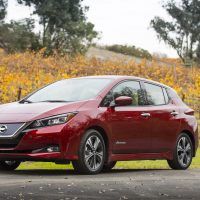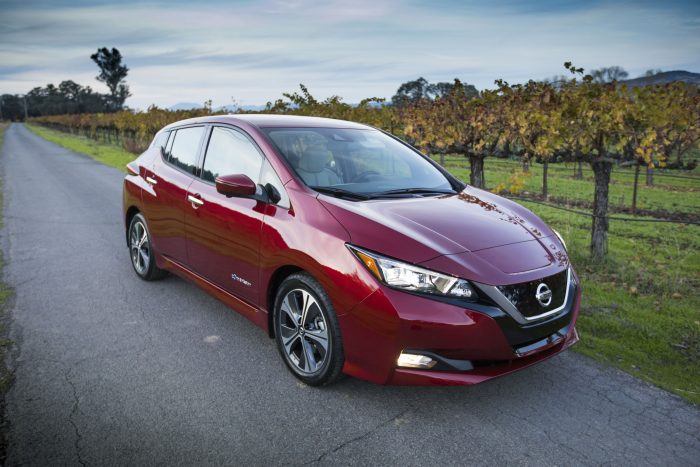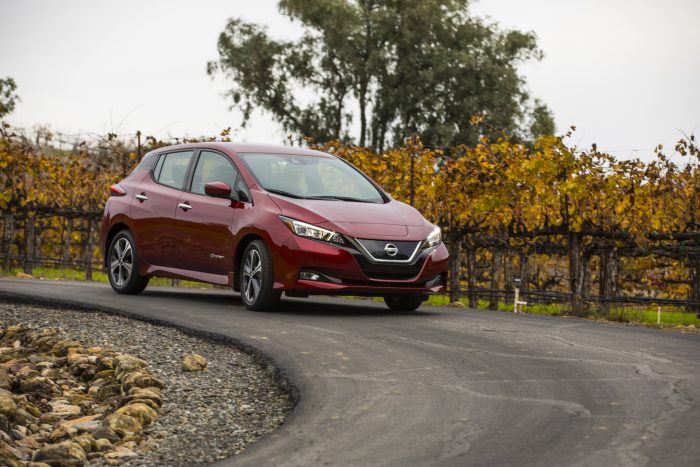Although the new Nissan Leaf shares the platform with its predecessor, that is where the similarities end. Both the interior and exterior have been completely redesigned, as well as the battery and drive motor for increases in range and power. The updates don’t stop there either: the steering and suspension have been tuned and tightened, and the chassis has been firmed. The styling changes are apparent too, and safety features like Pro Pilot Assist and Intelligent Cruise Control set the 2018 Nissan Leaf apart in the segment.
We recently attended a media event organized by Nissan to see the 2018 Leaf. The vehicle’s name is an acronym for “Leading, Environmentally Friendly, Affordable, Family Car,” so it’s only fitting the 2018 model preview took place at the beautiful LEED Platinum-certified Bardessono Hotel in Napa County, California. LEED stands for Leadership in Energy and Environmental Design.
First Impressions
Nissan asked for customer feedback and have clearly taken note. When you see the new Leaf, it’s quite apparent it looks nothing like the one of yore. Very little semblance to the awkward lines and frog-like face can be found in this sharp, new design. Aesthetic appeal can be an emotional topic and it’s always subjective. However, opinions aside, the new styling Nissan has adopted is a significant departure from what we have become accustomed to regarding the Leaf, and most EVs from the onset. The “floating” roof with blacked out C-pillars, as well as the “V-motion grille” is found on other cars in Nissan’s lineup. The Leaf has clearly been brought into the fold and shares noticeable DNA with its gasoline-powered brethrens. The redesign is a welcome refinement and far less polarizing than the previous amphibious-faced rendition.
The family resemblance carries over to the interior as well. The vehicle as tested was a well-appointed SL trim, sporting leather-wrapped bucket seats, and a leather-stitched steering wheel, both electronically heated. The seats are firm but comfortable and the instrumentation layout is orderly and intuitive. The infotainment system is equally orderly and instinctive to use. Although the infotainment center has a similar shape to a tablet, there was clear consideration put into integrating the ubiquitous shape, opposed to the common practice of plunking an iPad lazily onto the dash.
However, there are a couple of drawbacks: some of the plastic-ey interior styling accents are quite Sentra-esque and, to be brutally honest, there is more of it than expected at this $37,000 price point. The steering wheel is adjustable but no telescoping action. The wheel position may be an issue for taller drivers as the battery pack sits below the seats, forcing a relatively high driving position. The driver’s seat used to feel a bit like sitting in the cockpit of a shrunken minivan, but now feels like the cabin of a modern car, so there is some improvement there.
Enhanced Tech & Drivetrain: Obvious to Obscure
Although volumetrically the battery pack is the same size, Nissan cleverly increased its density by using a thinner separator and more efficient materials. By reducing the size of the separator, Nissan has allowed for greater battery cell density, essentially fitting more cells into the same amount of space. This means you get significantly more storage capacity and noticeably more power in the same amount of space, from 30kW to 40kW to be exact. This equates to roughly 150 miles on a single charge, boosting horsepower from 107 to 147, while torque climbs to 236 lb-ft.
Apple Car Play, Android Auto, and NissanConnect with navigation are optional, but vehicle tracking is one of the most unique features available. The vehicle can be tracked in real-time to make sure it stays where you left it; parents can even monitor a new driver. With EV Telematics, owner’s can set geographical boundaries on Google maps, triggering a notification to an app when the vehicle breaches the perimeter. Since Nissan has partnered with Amazon, many of the Leaf’s features, like climate control, can be activated by speaking to Alexa.



Ride & Handling
We’ve discussed the obvious and shed some light on the obscure, but this is an automobile, and the real question is how does it drive? The details of exactly what has been changed suspension-wise are a bit vague, but it’s Nissan’s claim the chassis has been “enhanced” and the steering torsion bar stiffened 10 percent. Upon entering the beautifully curvaceous B roads of Napa Valley, the steering did feel quite lithe and the feedback is surprisingly concise. The ride is a bit stiff over the rough parts but comfortable under most conditions. The 2018 Leaf has grown one inch both in length and width over previous generations to 176 by 71 inches respectively; the height remains the same at 61.4 inches.
This fact begs the question, what has transpired in the chassis development to eliminate the tall, spongy feel that befell the original? Nissan attributes the enhanced feedback and steering feel to new control logic software, which utilizes steering angle sensors and Intelligent Ride Control for managing torque under cornering. Combine the improved handling with the increased torque, and you have a recipe for fun. In an EV no less!
Advanced Drive Modes
Like most passenger cars with automatic transmissions, there are three familiar drive indicators: “D” “N” and “R.” As you might expect, there is an ECO mode that reduces the impact of acceleration, increases regenerative braking, and even augments the HVAC to maximize battery life. Interestingly there is a “B” accommodating the “D” on the shift knob. This mode essentially feels like driving in a lower gear, creating regenerative engine braking with 2.5 times more deceleration than “D.” None of these features are revolutionary or even uncommon, however, the e-Pedal is a feature that’s uniquely electric, and included on every trim level.
This feature is sincerely conflicting for me. As a proponent of driver involvement and a member of the Manual Transmission Preservation Society, it seems somewhat contradictory I should enjoy a driving characteristic like e-Pedal; it’s fun yet uninvolving. The e-Pedal allows the driver to navigate with a single pedal (according to a study conducted by Nissan) 90 percent of the time. Not two, not three, but one pedal to accelerate, cruise, slow, even come to a complete stop and hold stationary.
This is made possible by the unique function of the electric drivetrain. Rather than applying the standard friction brake, the drive motor creates resistance capable of bringing the vehicle to a stop extraordinarily and smoothly, simply by lifting your foot from the accelerator. Not only will it slow down at a rate of 0.2 g, but it charges the battery during deceleration. The feeling can be likened to driving in second gear with increased throttle response and aggressive engine braking. Nonetheless, I found myself driving the test vehicle in e-Pedal mode most of the time … that is, when the Pro Pilot Assist was not activated.
Nearly Autonomous Driving
Pro Pilot Assist is the combination of active radar cruise control (Intelligent Cruise Control) in concert with lane departure and lane guidance assist. Intelligent Cruise Control is like other radar based systems, in that the vehicle will match the speed of the car ahead. When traffic impedes forward progress, the radar detects the obstruction, then slows and accelerates to match the speed of traffic. There are three time-gap-based distance settings in the assist mode, so the driver can adjust how closely they want to follow the car ahead.
The lane guidance is based on a visual system that uses a camera to scan the road for visual inputs, namely the lines. Some lane departure and lane guidance aides wait for a vehicle to come within an approach boundary to intervene and prevent inadvertently crossing lanes. The Nissan system is more of a constant guide, gently shepherding the automobile toward the center of the lane without abruptly bouncing to and fro across it. Pilot is an apt name due to its ability to navigate subtle curves in the road, and it is probably capable of negotiating turns greater than I had the nerve to allow without intervention. Slow moving traffic is where Pro Pilot Assist really shines.
Alarm Bells
Nissan has shrewdly added layers of safety so Pro Pilot is not abused as a purely autonomous autopilot. The dash will flash warning lights if no driver is detected at the steering wheel for 5 seconds. Should the driver not have a hand, or even a finger on the wheel after the warning lights flash, obnoxious beeping will ensue. If the alarm is allowed to reach the equivalent of cardiac arrest, Pro Pilot Assist will pump the brakes three times while synchronously beeping insufferably. If this hasn’t jarred the driver awake, evoking some sort of input, the Leaf takes matters into its own hands and assumes the driver is somehow incapacitated.
The system can bring the vehicle to a stop from 40 mph and flash the hazard lights. This final emergency stop phase is where the noises get interesting. A whooping “Red Alert” siren sounds, and were it not an actual emergency, the audible alarm is quite comical. Being the Leaf is virtually silent, this may be the best noise the car makes (unless you have the optional Bose audio package). All kidding aside, this smart tech, along with safety features like automatic emergency braking and pedestrian detection, may very well save lives.
Conclusion
The Nissan Leaf is the most popular car in a growing EV market. It’s not a sports car, its not a luxury car, or even a Hot Hatch. It is not meant to be any of these things, and that is evident. What the Leaf is though, is an excellent commuter, and a great city car. With the extended range and ever-growing DC quick-charging network, it can be more than a mode of transport confined to city limits. The Leaf is a zero-emissions leader with flavors of sport, style, and a dash of luxury. Nissan has shown battery-operated vehicles can be packed with technology at a lower price than previous generations.
As popularity is gained in the EV market and competition increases, I believe this trend will progress and prices will continue to fall. For myself, the exciting thing about driving the new Leaf is the noticeable increase in power and torque, yet you know performance has been tuned down for the sake of sensibility. So, I can’t help wondering what the future holds if say a lightened NISMO version of the Leaf were released to the public. Or even better, a purpose-built affordable FUN EV!
Benjamin Caschera is a car nut in every sense of the word. His eclectic writings range from rants on traffic and wrenching on $500 cars, to adulation of the finest classic and/or latest hypercars. Follow and heckle him on Twitter and Instagram: @TheBoringCarGuy
2018 Nissan Leaf Gallery












Photos: Nissan Motor Corporation, Leaf Media Drive.
from Automoblog.net http://www.automoblog.net/2017/12/18/cruising-napa-valley-2018-nissan-leaf/
via IFTTT
from Tumblr http://peternpalmer.tumblr.com/post/168693334526
via IFTTT





No comments:
Post a Comment